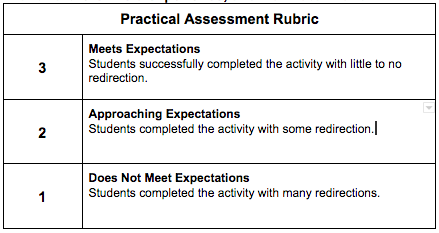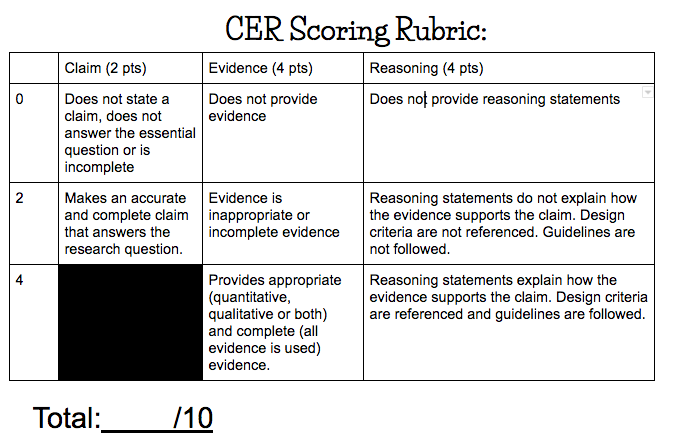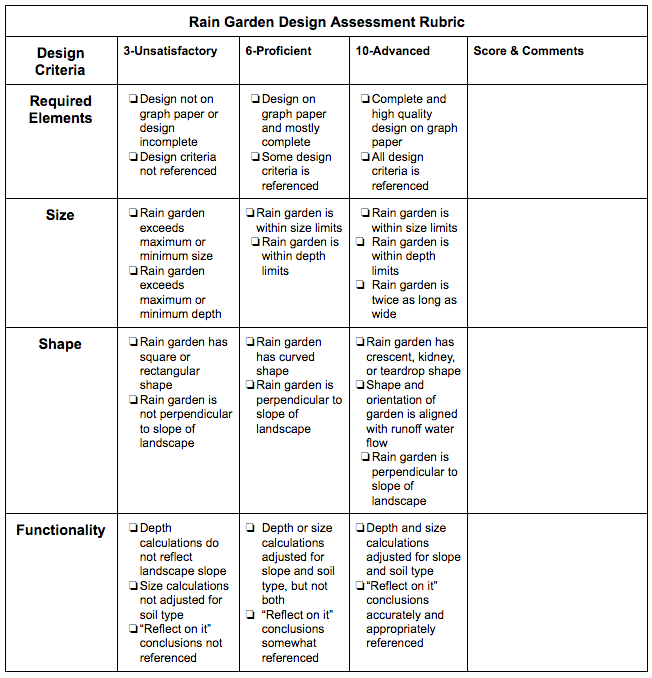5th Grade Rain Garden Design Challenge Lesson Plan
Content Area Lesson Plan Template
Preliminary Information
| Lesson Title: Rain Garden Design Challenge | Date Created:10-1-2018 |
| Grade: 5 | Course/Subject and Literacy Focus: Science |
| Unit/Theme: Nonpoint source pollution and Human Design Solutions | Estimated Duration: 210 instructional minutes: 120 minutes in Part 1 (Field Investigation) and 90 minutes in Part 2 (Design Engineering Solution). Each part can be subdivided into smaller time sections, spread over several days, if needed |
| Where in the unit does this lesson occur?(Double click box to activate check mark.)☐End of the unit | Structure(s) or grouping for the lesson (Check any that apply) (Double click box to activate check mark.)☐Whole class- Yes☐Small group- Yes |
Subject-Specific Content: Big Idea, Concept, or Skill Being Taught (including WI Academic Standard/s for your content area). Identify learning goals for students; be sure to state at least one for Content learning and at least one for Literacy gains.
| This unit fits in to the “Use Resources Wisely” sequence of the 5th grade Reedsburg School District Science curriculum. The unit description is:“Human activities in agriculture, industry, and everyday life have had major effects on the land, vegetation, streams, ocean, air, and even outer space. Individuals and communities are doing things to help protect Earth's resources and environments.” This unit combines with the ongoing “Engineering Design” unit, described as follows:“Solutions will be designed throughout the year to address problems using research, frequent testing, and limits of available materials, time, and resources.” The content area literacy goal for students is: “Obtain and combine information about ways individual communities use science ideas to protect the Earth's resources and environment.” This goal corresponds to the Common Core Standards for Reading and Speaking below: RI.5.7 Draw on information from multiple print or digital sources, demonstrating the ability to locate an answer to a question quickly or to solve a problem efficiently. SL.5.5 Include multimedia components (e.g., graphics, sound) and visual displays in presentations when appropriate to enhance the development of main ideas or themes. Students complete this lesson after they have:
|
| The big idea in this lesson is that students will utilize prior knowledge and design model concepts and practices from the classroom-based “Hands-On Standards STEM In Action - Rainwater Runoff Design, Grade 5” to situate and design a rain garden in a real-world context to address a real world problem on school forest property. Students have experienced hypothetical design constraints, such as cost, materials, and space issues, in a simulated classroom environment. They will now apply what they have learned to the design of an actual rain garden to address non-point source pollution, runoff and erosion on school forest property. This lesson addresses the following Next Generation Science Standards (NGSS): 5-ESS3-1. Obtain and combine information about ways individual communities use science ideas to protect the Earth’s resources and environment. 5-LS2-1. Develop a model to describe the movement of matter among plants, animals, decomposers, and the environment. 5-ESS2-1. Develop a model using an example to describe ways the geosphere, biosphere, hydrosphere, and/or atmosphere interact. The Science and Engineering Practices utilized in this lesson are “Developing and Using Models - Develop a model to describe phenomena...a scientific principle...and use models to represent events and design solutions.” The Cross Cutting Concepts utilized in this lesson are “Systems and System Models - A system can be described in terms of its components and their interactions.” The Disciplinary Core Ideas utilized in this lesson are: LS2.B: Cycles of Matter and Energy Transfer in Ecosystems -Matter cycles between the air and soil and among plants, animals, and microbes as these organisms live and die. Organisms obtain gases, and water, from the environment, and release waste matter (gas, liquid, or solid) back into the environment. ESS2.A: Earth Materials and Systems - Earth’s major systems are the geosphere (solid and molten rock, soil, and sediments), the hydrosphere (water and ice), the atmosphere (air), and the biosphere (living things, including humans). These systems interact in multiple ways to affect Earth’s surface materials and processes. |
| The literacy focus for this lesson is primarily oral/speaking and listening, accompanied with text-based/reading and writing-based. Students must make a claim, supported with evidence, on what they think is the best site for the rain garden, and make a model of the best design for the rain garden. This part of the lesson will be completed in small groups. Students will evaluate each other’s claims and models. Claims and models will also be assessed summatively with a rubric. The literacy goal for students is: “Obtain and combine information about ways individual communities use science ideas to protect the Earth's resources and environment.” This goal corresponds to the Common Core Standards for Reading and Speaking below: RI.5.3 Explain the relationships or interactions between two or more individuals, events, ideas, or concepts in a historical, scientific, or technical text based on specific information in the text. RI.5.7 Draw on information from multiple print or digital sources, demonstrating the ability to locate an answer to a question quickly or to solve a problem efficiently. SL.5.5 Include multimedia components (e.g., graphics, sound) and visual displays in presentations when appropriate to enhance the development of main ideas or themes. |
| This literacy focus is appropriately authentic because students must combine information from multiple texts, including print and media resources, real-world data collected through science field investigations, and feedback generated by peers and instructors to explain and evaluate relationships, develop and evaluate solutions to problems, draw conclusions from multiple sources of information, and modify ideas and concepts to fit new information and evidence. |
Student content learning goal - Situate and design a rain garden to control/reduce runoff and non-point source pollution on school forest property.Objectives:
|
Student content learning goal - Students situate and design a rain garden to control/reduce runoff and non-point source pollution on school forest property.
Objective 1) Students identify areas of erosion and non-point source pollution entering waterways on school forest property
Assessment #1 - Using the school forest property map, students will work in groups to draw circles indicating areas that show three or more indications of erosion and/or runoff according to a checklist of criteria. At least one circle on the map must be drawn, with specific evidence criteria for erosion/runoff cited. (see Step 1 of “Rain Garden Location & Design Challenge” handout).
Objective 2) Students determine the suitability of potential rain garden installation areas by conducting field tests on slope and soil type
Assessment #2 - Students will work in groups to measure and record data in Table 1 for Slope Measurements and Table 2 for Soil Type Suitability on the “Rain Garden Location & Design Challenge” handout.
Objective 3) Students will test for the presence of phosphates in waterways on school forest property
Assessment #3 - Students will work in groups to measure and record data in Table 3 for the amount of phosphate on the “Non-point Source Pollution: Phosphate” handout.
Objective 4) Students write and peer evaluate “suitable site” claims for where the rain garden should be located on school forest property;
Assessment #4 -Students will use field data collected, maps from Objective #1, previous results of prototype soil mixtures (from completed “Hands-On Standards STEM In Action - Rainwater Runoff Design, Grade 5”) and rain garden design criteria to write Claim-Evidence-Reasoning posters on the best location for a rain garden on the school forest property.
Objective 5) Students use previous data collected and rain garden design constraints to propose a rain garden design to classmates
Assessment #5 - Students create a 2-dimensional rain garden model that meets the size, shape, and functionality criteria of the rain garden design constraints and display in poster format on graph paper with the CER location claim (see “Rain Garden Design Challenge Criteria” handout)
Objective 6) Students evaluate proposals using a provided rubric and make a recommendation on the best rain garden designs
Assessment #6 - Students use the CER Scoring Rubric and Rain Garden Design Assessment Rubric to score each other’s design proposals
Method for evaluating/Criteria for learning:
A Formative Assessment Rubric (see below) will be used by the instructor to score objectives #1-3; A Summative Assessment Rubric (see below) will be used by students and the instructor to score objective #4; and a Summative Assessment Rubric (see below) will be used by students and the instructor to score objectives #5-6.
Means of Recording: The instructor will mark appropriate points earned in the gradebook for summative and formative assessments.



Learning Activities/Literacy Support Strategy/Resources and Materials
| Part 1 (Field Investigation): Non-point Source Pollution and Rain Garden Suitability Siting This portion of the lesson will require a minimum of 120 instructional minutes, including 30 minutes in class and 90 minutes on school forest property conducting field investigations. Objective 1-3:
Materials needed: 1 per group of 4 students
Safety Goggles Safety:Follow all school safety considerations when traveling to, from and between stations. Students should be prepared for all weather conditions with proper outdoor clothing and footwear. Have a First Aid kit, emergency cell phone, student health/field trip permission forms, and any other documentation required by your school or district on site. Confirm that all students requiring medications have them on their person or a designated adult has medications accessible during field investigation activities. In-class preparation:Before this field experience, students should already have completed the “Hands-On Standards STEM In Action - Rainwater Runoff Design, Grade 5” module. Therefor, students should already have 1) conducted in-class investigations on the sources and contents of non-point source pollution; 2) researched rain gardens as a potential engineering design solution for preventing and treating runoff; and 3) designed and presented two-dimensional rain garden models, receiving feedback from peers/classmates. The following field experiences will provide the opportunity and guidance to investigate and apply what they have learned in the classroom to a real-world context on school forest property. Before going to the field study site, review all equipment needed for Stations #1 and #2. Review all instructions included in the “Rain Garden Location & Design Challenge” and “Non-point Source Pollution: Phosphate” Field Data Sheets. Showcase equipment needed for each step of each process on the Field Data Sheets. Divide students into groups of no more than four per group. Distribute equipment among student groups to carry in backpacks, or arrange for student volunteers to transport equipment in tubs to the station locations once on school forest property. Station #1: Materials needed:1 per group of 4 students
Station #2: Materials needed: 1 per group of 4 students
Location (Siting) criteria:
|
Student literacy learning goal #1 - Obtain and combine information about ways individual communities use science ideas to protect the Earth's resources and environment.”Each activity in the objective list below is scaffolded using several types of supports: guided field data investigation sheets, assessment scoring rubrics, template formats, criteria checklists, and questioning prompts. All activities are designed to create supports for students to become authentically literate in the content area. Objectives:
|
| Resources: Hands-On Standards STEM In Action - Rainwater Runoff Design, Grade 5“Rain Gardens: A How-To Manual for Homeowners,” University of Wisconsin-Extension Publication GWQ037/DNR Publication PB-WT-776 2003“Rain Gardens: A Household Way to Improve Water Quality in your Community,” UWEX #GWQ034 WDNR #WT-731, both available for pdf download at: http://clean-water.uwex.edu/pubs/Wisconsin Native Plant Sources and Restoration Consultants“Reducing Erosion and Runoff,” Virginia Cooperative Extension, Virginia Tech Communications and Marketing, College of Agriculture and Life Sciences, 2017, Publication 426-722, www.ext.vt.edu |